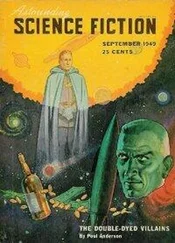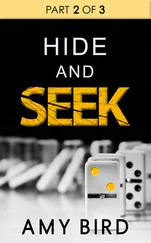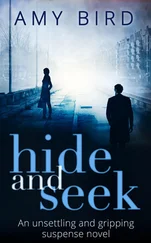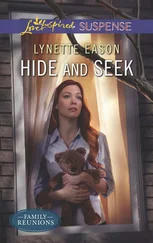Уилки Коллинз - Hide and Seek
Здесь есть возможность читать онлайн «Уилки Коллинз - Hide and Seek» весь текст электронной книги совершенно бесплатно (целиком полную версию без сокращений). В некоторых случаях можно слушать аудио, скачать через торрент в формате fb2 и присутствует краткое содержание. Год выпуска: 2005, Жанр: Классическая проза, на английском языке. Описание произведения, (предисловие) а так же отзывы посетителей доступны на портале библиотеки ЛибКат.
- Название:Hide and Seek
- Автор:
- Жанр:
- Год:2005
- ISBN:нет данных
- Рейтинг книги:5 / 5. Голосов: 1
-
Избранное:Добавить в избранное
- Отзывы:
-
Ваша оценка:
- 100
- 1
- 2
- 3
- 4
- 5
Hide and Seek: краткое содержание, описание и аннотация
Предлагаем к чтению аннотацию, описание, краткое содержание или предисловие (зависит от того, что написал сам автор книги «Hide and Seek»). Если вы не нашли необходимую информацию о книге — напишите в комментариях, мы постараемся отыскать её.
Hide and Seek — читать онлайн бесплатно полную книгу (весь текст) целиком
Ниже представлен текст книги, разбитый по страницам. Система сохранения места последней прочитанной страницы, позволяет с удобством читать онлайн бесплатно книгу «Hide and Seek», без необходимости каждый раз заново искать на чём Вы остановились. Поставьте закладку, и сможете в любой момент перейти на страницу, на которой закончили чтение.
Интервал:
Закладка:
After standing before his picture in affectionate contemplation of its beauties for a minute or so, Valentine resumes the business of preparing his palette.
As the bee comes and goes irregularly from flower to flower; as the butterfly flutters in a zig-zag course from one sunny place on the garden wall to another—or, as an old woman runs from wrong omnibus to wrong omnibus, at the Elephant and Castle, before she can discover the right one; as a countryman blunders up one street, and down another, before he can find the way to his place of destination in London—so does Mr. Blyth now come and go, flutter, run, and blunder in a mighty hurry about his studio, in search of missing colors which ought to be in his painting-box, but which are not to be found there. While he is still hunting through the room, his legs come into collision with a large drawing-board on which there is a blank sheet of paper stretched. This board seems to remind Mr. Blyth of some duty connected with it. He places it against two chairs, in a good light; then approaching a shelf on which some plaster-casts are arranged, takes down from it a bust of the Venus de Medici—which bust he next places on his old office stool, opposite to the two chairs and the drawing-board. Just as these preparations are completed, the door of the studio opens, and a very important member of the painter’s household—who has not yet been introduced to the reader, and who is in no way related either to Valentine or his wife—enters the room.
This mysterious resident under Mr. Blyth’s roof is a Young Lady.
She is dressed in very pretty, simple, Quaker-like attire. Her gown is of a light-gray color, covered by a neat little black apron in front, and fastened round the throat over a frill collar. The sleeves of this dress are worn tight to the arm, and are terminated at the wrists by quaint-looking cuffs of antique lace, the only ornamental morsels of costume which she has on. It is impossible to describe how deliciously soft, bright, fresh, pure, and delicate, this young lady is, merely as an object to look at, contrasted with the dingy disorder of the studio-sphere through which she now moves. The keenest observers, beholding her as she at present appears, would detect nothing in her face or figure, her manner or her costume, in the slightest degree suggestive of impenetrable mystery, or incurable misfortune. And yet, she happens to be the only person in Mr. Blyth’s household at whom prying glances are directed, whenever she walks out; whose very existence is referred to by the painter’s neighbors with an invariable accompaniment of shrugs, sighs, and lamenting looks; and whose “case” is always compassionately designated as “a sad one,” whenever it is brought forward, in the course of conversation, at dinner-tables and tea-tables in the new suburb.
Socially, we may be all easily divided into two classes in this world—at least in the civilized part of it. If we are not the people whom others talk about, then we are sure to be the people who talk about others. The young lady who had just entered Mr. Blyth’s painting-room, belonged to the former order of human beings.
She seemed fated to be used as a constant subject of conversation by her fellow-creatures. Even her face alone—simply as a face—could not escape perpetual discussion; and that, too, among Valentine’s friends, who all knew her well, and loved her dearly. It was the oddest thing in the world, but no one of them could ever agree with another (except on a certain point, to be presently mentioned) as to which of her personal attractions ought to be first selected for approval, or quoted as particularly asserting her claims to the admiration of all worshippers of beauty.
To take three or four instances of this. There was Mr. Gimble, the civil little picture-dealers and a very good friend in every way to Valentine: there was Mr. Gimble, who declared that her principal charm was in her complexion—her fair, clear, wonderful complexion—which he would defy any artist alive to paint, let him try ever so hard, or be ever so great a man. Then came the Dowager Countess of Brambledown, the frolicsome old aristocrat, who was generally believed to be “a little cracked;” who haunted Mr. Blyth’s studio, after having once given him an order to paint her rare China tea-service, and her favorite muff, in one group; and who differed entirely from the little picture-dealer. “Fiddle-de-dee!” cried her ladyship, scornfully, on hearing Mr. Gimble’s opinion quoted one day. “The man may know something about pictures, but he is an idiot about women. Her complexions indeed! I could make as good a complexion for myself (we old women are painters too, in our way, Blyth). Don’t tell me about her complexion—it’s her eyes! her incomparable blue eyes, which would have driven the young men of my time mad—mad, I give you my word of honor! Not a gentleman, sir, in my youthful days—and they were gentlemen then—but would have been too happy to run away with her for her eyes alone; and what’s more, to have shot any man who said as much as ‘Stop him!’ Complexion, indeed, Mr. Gimble? I’ll complexion you, next time I find my way into your picture-gallery! Take a pinch of snuff, Blyth; and never repeat nonsense in my hearing again.”
There was Mr. Bullivant, the enthusiastic young sculptor, with the mangy flow of flaxen hair, and the plump, waxy face, who wrote poetry, and showed, by various sonnets, that he again differed completely about the young lady from the Dowager Countess of Brambledown and Mr. Gimble. This gentleman sang fluently, on paper—using, by the way, a professional epithet—about her “chiselled mouth”,
“Which breathed of rapture and the balmy South.”
He expatiated on
“Her sweet lips smiling at her dimpled chin,
Whose wealth of kisses gods might long to win—”
and much more to the same maudlin effect. In plain prose, the ardent Bullivant was all for the lower part of the young lady’s face, and actually worried her, and Mr. Blyth, and everybody in the house, until he got leave to take a cast of it.
Lastly, there was Mrs. Blyth’s father; a meek old gentleman, with a continual cold in the head; who lived on marvelously to the utmost verge of human existence—as very poor men, with very large families, who would be much better out of this world than in it, very often do. There was this low-speaking, mildly-infirm, and perpetually-snuffling engraver, who, on being asked to mention what he most admired in her, answered that he thought it was her hair, “which was of such a nice light brown color; or, perhaps, it might be the pleasant way in which she carried her head, or, perhaps, her shoulders—or, perhaps, her head and shoulders, both together. Not that his opinion was good for much in tasty matters of this kind, for which reason he begged to apologize for expressing it at all.” In speaking thus of his opinion, the worthy engraver surely depreciated himself most unjustly: for, if the father of eight daughters cannot succeed in learning (philoprogenitively speaking) to be a good judge of women, what man can?
However, there was one point on which Mr. Gimble, Lady Brambledown, Mr. Bullivant, Mrs. Blyth’s father, and hosts of friends besides, were all agreed, without one discordant exception.
They unanimously asserted that the young lady’s face was the nearest living approach they had ever seen to that immortal “Madonna” face, which has for ever associated the idea of beauty with the name of RAPHAEL. The resemblance struck everybody alike, even those who were but slightly conversant with pictures, the moment they saw her. Taken in detail, her features might be easily found fault with. Her eyes might be pronounced too large, her mouth too small, her nose not Grecian enough for some people’s tastes. But the general effect of these features, the shape of her head and face, and especially her habitual expression, reminded all beholders at once, and irresistibly, of that image of softness, purity, and feminine gentleness, which has been engraven on all civilized memories by the “Madonnas” of Raphael.
Читать дальшеИнтервал:
Закладка:
Похожие книги на «Hide and Seek»
Представляем Вашему вниманию похожие книги на «Hide and Seek» списком для выбора. Мы отобрали схожую по названию и смыслу литературу в надежде предоставить читателям больше вариантов отыскать новые, интересные, ещё непрочитанные произведения.
Обсуждение, отзывы о книге «Hide and Seek» и просто собственные мнения читателей. Оставьте ваши комментарии, напишите, что Вы думаете о произведении, его смысле или главных героях. Укажите что конкретно понравилось, а что нет, и почему Вы так считаете.











